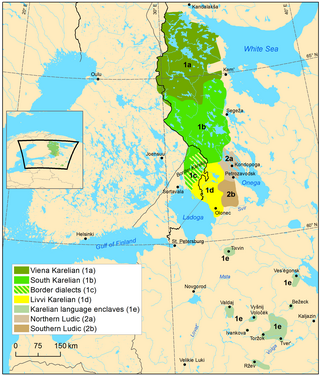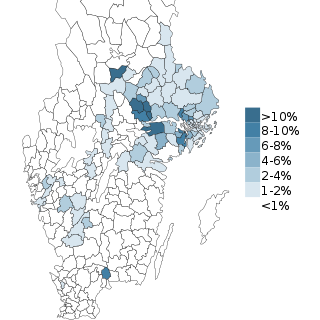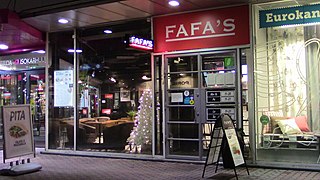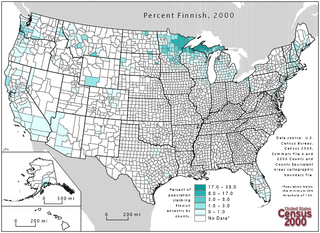
Helsinki is the capital, largest and most populous city in Finland. Located on the shore of the Gulf of Finland, it is the seat of the Uusimaa region in southern Finland. Approximately 0.67 million people live in the municipality, with 1.25 million in the capital region, and 1.58 million in the metropolitan area. The region is by far the most populous urban area in Finland and the country's most important centre for politics, education, finance, culture and research. Helsinki is located 80 kilometres (50 mi) north of Tallinn, Estonia, 362 km north of Riga, Latvia 400 km (250 mi) east of Stockholm, Sweden, and 300 km (190 mi) west of Saint Petersburg, Russia. It has close historical links with these four cities.
Colloquial or spoken Finnish is the unstandardized spoken variety of the Finnish language, in contrast with the standardized form of the language. It is used primarily in personal communication and varies somewhat between the different dialects.
Helsingin Sanomat, abbreviated HS and colloquially known as Hesari, is the largest subscription newspaper in Finland and the Nordic countries, owned by Sanoma. Except after certain holidays, it is published daily. Its name derives from that of the Finnish capital, Helsinki, where it is published. It is considered a newspaper of record for Finland.

Kuopio is a Finnish city and municipality located in the region of Northern Savonia. It has a population of approximately 124,000, which makes it the 8th most populous municipality in Finland. Along with Joensuu, Kuopio is one of the major urban, economic, and cultural hubs of Eastern Finland. At the end of 2018, its urban area had a population of approximately 90,000.
The term Finglish was coined by professor Martti Nisonen in the 1920s in Hancock, Michigan, United States, to describe a mixture of Finnish and English he encountered in America. The word is first recorded in English in 1943.

Ludic, or Ludian, or Ludic Karelian, is a Finnic language in the Uralic language family or a Karelian dialect. It is transitional between the Olonets Karelian language and the Veps language. It is spoken by 300 Karelians in the Republic of Karelia in Russia, near the southwestern shore of Lake Onega, including a few children.
Helsinki slang or stadin slangi is a local dialect and a sociolect of the Finnish language mainly used in the capital city of Helsinki. It is characterized by its abundance of foreign loan words not found in the other Finnish dialects.

Rauma dialect is a Southwestern dialect of Finnish spoken in the town of Rauma, Finland.

Finland has participated in the Eurovision Song Contest 56 times since its debut in 1961. Finland won the contest for the first – and to date only – time in 2006 with Lordi and their song "Hard Rock Hallelujah". The country's best result before then was achieved by Marion Rung with the song "Tom Tom Tom" in 1973, which placed sixth.
Somalis in Finland are residents and citizens of Finland of Somali ancestry. As of 2022, 24,365 Finns had a Somali-background, making it the fourth most common foreign country of origin and the largest from Africa.
Helsinki Times is the first English-language daily online newspaper in Finland providing domestic and international news for the country's English-speaking readers. A weekly printed edition was issued between 2007 and 2015.

Fingerpori is a Finnish comic strip written and drawn by Pertti Jarla. It started in Helsingin Sanomat in February 2007, and is comprehensively distributed in major provincial newspapers. Literally, fingerpori is a thimble, but fingerporillinen is a proverbial small amount of alcohol, and Pori is a Finnish town.

Anna Sofia Eriksson is a Finnish artist, filmmaker, composer, and singer. In September 2018, avantgarde film M directed and produced by Eriksson was having the world premiere at the Venice International Film Critics Week, 75th Venice International Film Festival. Eriksson is one of the most successful singers in Finnish chart history.

Ismo Mikael Leikola, sometimes known professionally as ISMO, is a Finnish stand-up comedian, musician, author, screenwriter, and YouTuber. Leikola made his United States debut in 2014, when he won "The Funniest Person in the World" competition organized by the comedy club Laugh Factory. In 2015, he made comedy series ISMO for Finnish television and moved to the United States. He gained more recognition after his appearance on the Conan talk show in 2018 and has since toured internationally. He has a YouTube channel with over 360,000 subscribers.

Pertti Kurikan Nimipäivät was a Finnish punk rock band, formed in 2009 in a charity workshop for adults with developmental disabilities. They are the main focus of the 2012 Finnish documentary film The Punk Syndrome. In 2015, they qualified for the finals of Uuden Musiikin Kilpailu, which they later won; they represented Finland in the Eurovision Song Contest 2015 but got knocked out in the semi-final. The group disbanded in December 2016 when guitarist Pertti Kurikka turned 60 years old and retired from playing punk rock.
Arabs in Finland are residents and citizens of Finland who speak the Arabic language.

Power Belongs to the People formerly known as Parliamentary Group Ano Turtiainen (AT), is a political party in Finland. Ano Turtiainen is its group leader and was its only member of parliament. The group's rules state that the purpose of the group's activities is "to act in parliament in the interests of Finland and Finns and to have freedom of speech in elections".

Sweden Finnish is the variety of Finnish spoken in Sweden by around 250,000 active speakers. The grammar of Sweden Finnish does not significantly differ from Standard Finnish, but it does however contain some Swedish terminology. Sweden Finnish is the result of Finnish immigrants arriving in Sweden, mainly between 1954 and 1970. Possessive suffixes are rarely used in Sweden Finnish, but some words are used as articles.

Fafa's is a Finnish fast food restaurant chain founded in 2011, serving falafel, pita and salads. The chain has 40 restaurants in Finland, two in Sweden and one each in Estonia and in the United Kingdom. The Fafa's restaurants work on a franchising principle. Fafa's is the first completely carbon-neutral restaurant chain in Finland.

Lakeside Murders is a Finnish crime drama and Nordic noir television series created by Riku Suokas and starring Eero Aho. The series is based on the Koskinen book series by Seppo Jokinen and follows Inspector Sakari Koskinen and his team in the Violent Crimes Unit as they try to solve murders in the Finnish lakeside city of Tampere.














